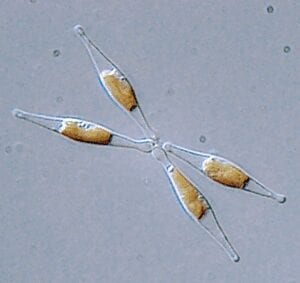Plastic Fantastic
Poly-3-hydroxybutyrate (PHB) is a thermoplastic polyester which occurs naturally in bacteria as Ralstonia eutropha and Bacillus megaterium. Even though PHB is biodegradable and is not dependent on fossil resources, this bioplastic has been traditionally too expensive to produce to replace petroleum-based plastics.
New research reported in BioMed Central‘s open access journal Microbial Cell Factories describes an alternative method of producing PHB in microalgae.
PHB is synthesised in bacteria from acetyl-CoA using the enzymes ß-ketothiolase, acetoacetyl-CoA reductase and PHB synthase. The genes coding for these proteins were inserted into a diatom (Phaeodactylum tricornutum) resulting in expression of the enzymes and synthesis of PHB in cytosolic granules. After only seven days, about 10% of the dried weight of the diatoms was PHB.
Dr. Franziska Hempel and Prof Uwe Maier from the LOEWE-Centre Synmikro in Marburg, and Prof Alexander Steinbüchel from Westfälische Wilhelms-Universität, explained, “Millions of tons of petroleum-based plastic are consumed every year worldwide causing immense amounts of waste that can take thousands of years to biodegrade — if at all. Bacterial fermentation is expensive and while people have introduced a similar system into plants, plants are relatively slow growing and biofuel agriculture uses up valuable land. P. tricornutum needs little more than light and water to grow and can produce similar amounts of PHB to the plant systems in weeks rather than months.”









